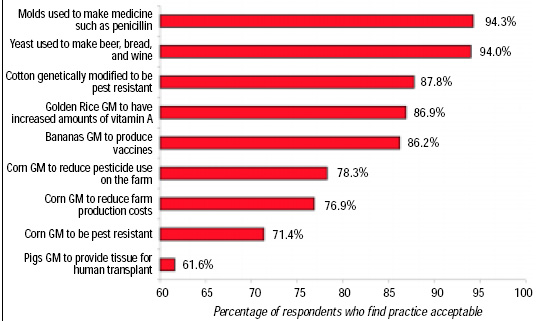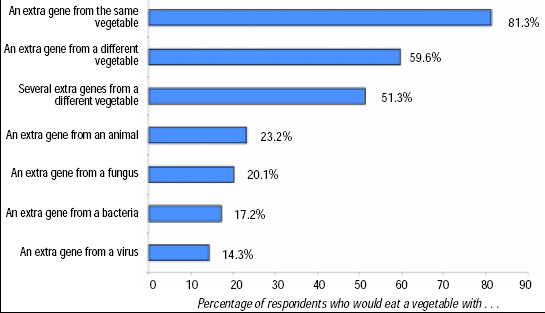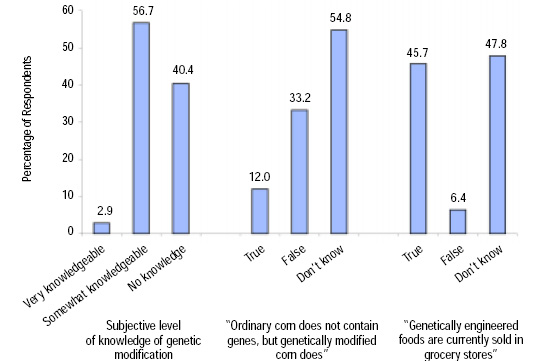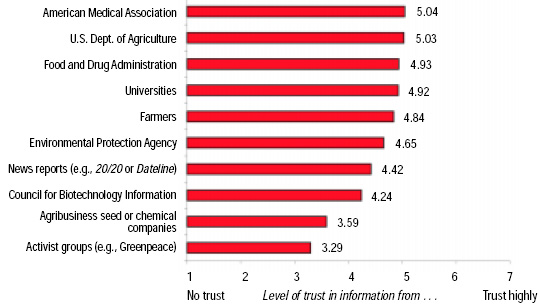Consumer Acceptance of Genetically Modified Foods
Consumer acceptance of and willingness to eat genetically modified foods depend on the reason for the modification and other factors.
Genetically modified (GM) crops have now been commercially produced for more than seven years. In 2001, more than 65% of soybean acres and more than 20% of corn acres were planted with GM varieties (Fernandez-Cornejo and McBride, 2002). Despite widespread acceptance of biotechnology at the farm level, consumer acceptance of the technology remains uncertain. Nevertheless, understanding consumer attitudes about biotechnology is extremely important for the food industry.
Consumer uncertainty about biotechnology could reduce consumption of foods with GM ingredients, both domestically and abroad, creating downward pressure on food prices. Furthermore, research and development in the food industry is often focused on developing foods with traits consumers desire. Development of GM foods is no different, and consumer research is needed to determine whether certain types of GM foods are appealing to the end user.
In addition, food companies that have invested in biotechnology and use GM ingredients must understand consumer attitudes about their products to design effective marketing and promotion strategies aimed at increasing demand for their products. These companies must also understand consumer attitudes about biotechnology to effectively defend against activist group attacks, such as the recent targeting of Kraft Foods by a coalition of consumer groups (Branch, 2002). Consumer opinions about biotechnology are also important for developing effective public policy, such as creating effective food labeling and understanding the effects of public-financed education.
A number of studies have analyzed consumer acceptance of biotechnology and GM foods (House et al., 2002), but a number of unresolved issues remain. For example, Lusk et al. (2002) found that consumers were more accepting of corn chips genetically modified to increase shelf life than those modified to increase farm yield, but it is unclear whether this result is extendable to all types of foods and all cases of genetic modification. If consumer acceptance of GM foods depends on the purpose for which the food was modified, the biotechnology industry may be able to shift focus from applications aimed at enhancing farm productivity to products that improve consumer well-being.
It is also unclear whether consumer acceptance of GM foods is directly related to purchasing behavior. A number of studies have measured attitudes toward and acceptance of biotechnology (e.g., Hoban, 1997), but these measures may not translate well into eating patterns, which are ultimately important for predicting food product sales.
Another unresolved issue is identification of factors that may influence acceptance of GM foods. It has been hypothesized that demographics, education, trust, perception of risks and benefits, and knowledge of biotechnology influence consumer acceptance of GM foods, but little consensus has been reached on the influence of these factors (Frewer et al., 1998; Hamstra, 2000; Israel and Hoban, 1992; Nestle, 1998).
Survey Conducted
We therefore conducted a mail survey to determine whether acceptance of GM foods varies by modification purpose and type of food; whether consumers who are accepting of GM foods are also willing to eat them; and which factors influence acceptance of GM foods.
• The Respondents. We mailed questionnaires to a random sample of consumers in Mississippi in fall 2001. Although the sample of respondents is geographically restricted, useful inferences can be drawn about the study objectives. If it is determined that consumers are sensitive to type of genetic modification, for example, a larger, more representative study may be warranted to determine if results hold across the U.S.
Of the 4,900 surveys sent out, 640 completed surveys were returned; after adjusting for undeliverable addresses, the response rate was 14%. To provide a consistent number of observations in the analysis that follows, we removed all partially completed surveys from the data set, which reduced the final number of observations to 418.
--- PAGE BREAK ---
As with any survey, the potential for sample selection bias exists. To control for differences between our sample and the population, we weighted our samples using U.S. census data for the state of Mississippi. This population-weighting technique “adjusts” the sample so that it is representative of the population, at least with respect to selected demographics (Kalton and Kasprzyk, 1986). After weights were applied, sample means for selected demographics equaled population means. For the remainder of the analysis, all results were derived statistics that incorporate the derived weights.
Approximately 67% of the respondents were female, likely because we requested that the primary household shopper fill out the survey. Because we employed population weighting, mean values of other demographic variables such as income, education, and age closely matched population means provided by the U.S. Census Bureau.
• The Questions. To provide subjects with some information about biotechnology, we included a brief information sheet that described genetic modification. The advent of golden rice, a new food genetically modified to contain higher amounts of beta-carotene, which the body converts to vitamin A, was discussed in the information sheet because a concurrent goal of this survey was to estimate consumer willingness to pay for golden rice vs traditional white rice.
We obtained basic demographic information, then asked a number of questions to determine consumers’ level of acceptance of GM foods. The first set of questions involved asking respondents to identify whether they found the development of several GM foods “acceptable” or “unacceptdeable.” Because acceptance may vary based on the type of food or purpose for the genetic modification, we presented respondents with a number of scenarios. The types of foods presented included corn genetically modified to be pest resistant, corn genetically modified to reduce pesticide use on the farm, corn genetically modified to reduce farm production costs, bananas genetically modified to produce vaccines, etc. We also asked respondents to evaluate non-food items such as cotton genetically modified to be pest resistant. For base-line scenarios, we asked respondents whether they found the following practices acceptable: molds used to make medicine such as penicillin, and yeast used to make beer, bread, and wine.
Although asking individuals whether certain biotechnology practices are acceptable may provide useful information, responses may be a poor predictor of market behavior. For example, individuals may believe that using biotechnology to create corn resistant to insects is “acceptable,” but they may not wish to consume this type of food. Therefore, we asked respondents another set of questions aimed at eliciting their willingness to consume vegetables that have been genetically modified in various ways. Specifically, we asked subjects whether they would eat a vegetable with an extra gene from the same vegetable, an extra gene from a different vegetable, several extra genes from a different vegetable, an extra gene from a bacteria, an extra gene from an animal, etc. We varied the type of modification in each question to determine whether consumers were averse to the entire concept of GM foods or whether acceptance and willingness to eat was sensitive to the type of genetic modification.
• The Hypothesis. We hypothesized that consumers’ acceptance of GM foods depends on their subjective and objective levels of knowledge of biotechnology, trust in information about GM foods from various information sources, overall attitudes toward factors such as the environment, religion, and personal health, and basic demographics:
Acceptance = f(knowledge, trust, attitudes, demographics) (1)
To measure the variables on the right-hand side of the equation, we asked respondents various questions. Subjective level of knowledge was determined by asking respondents how knowledgeable they were of GM foods. Objective level of knowledge was determined by asking two true/false questions. Level of trust in information about GM foods from various sources was elicited using Likert scale questions, asking respondents to rate sources such as the U.S. Dept. of Agriculture, the Food and Drug Administration, and farmers. Last, overall attitudes were measured by asking consumers to rate how important the environment, religion, survival of the family farm, personal health, and health of family were.
--- PAGE BREAK ---
To determine how these various factors influence consumer acceptance of GM foods, we employed a binomial logit model (Greene, 2000). Because respondents found various GM foods either “acceptable” or “unacceptable,” the dependent variables in Eq. 1 are qualitative. In this type of model, least-squares regression techniques are inappropriate. In this case, we are interested in predicting the probability that an individual would indicate that a GM food was “acceptable.” The dependent variable ACCEPT equals 1 if a respondent found a particular GM food acceptable and 0 if a respondent found it unacceptable. Eq. 2 outlines the logit model:
Prob(ACCEPT = 1) = eβx/(1 + eβx) (2)
where β is a vector of coefficients and x is a conformable vector of independent variables influencing the probability of acceptance, as identified in Eq. 1.
 • The Results. Fig. 1 reports the results of the first set of questions aimed at determining consumers’ level of acceptance of GM foods. Overall, acceptance levels were quite high, with more than 70% of respondents finding all foods acceptable. As expected, the most accepted practices involved traditional, non-GM foods. Ninety-four percent of consumers believed that yeast used to make beer, bread, and wine and molds used to make medicine such as penicillin were acceptable food production practices.
• The Results. Fig. 1 reports the results of the first set of questions aimed at determining consumers’ level of acceptance of GM foods. Overall, acceptance levels were quite high, with more than 70% of respondents finding all foods acceptable. As expected, the most accepted practices involved traditional, non-GM foods. Ninety-four percent of consumers believed that yeast used to make beer, bread, and wine and molds used to make medicine such as penicillin were acceptable food production practices.
Interestingly, the next most acceptable product was cotton genetically modified to be pest resistant. This product was likely more acceptable than many of the foods because cotton is not eaten, and as such, any fears over food safety were negligible. For example, 88% of the respondents considered cotton genetically modified to be pest resistant acceptable, whereas only 71% considered corn genetically modified to be pest resistant acceptable. This potentially implies that consumers are not necessarily averse to biotechnology in general, but have concerns about adverse health consequences from eating GM products.
The most acceptable foods were golden rice genetically modified to have increased amounts of vitamin A and bananas genetically modified to produce vaccines. Consumers likely find these foods more acceptable than others because they provide a direct benefit to the consumer through increased nutrition and health. This result is consistent with the findings of Lusk et al. (2002) that consumers were more likely to purchase corn chips with corn genetically modified to have longer shelf life than corn chips made with corn genetically modified to increase farm yields. Although consumers were more accepting of foods that provided a direct benefit for them, they also had high levels of acceptance of foods that provide indirect benefits, or perhaps none at all. More than 70% of the respondents found it acceptable to genetically modify corn to be pest resistant, reduce farm production costs, or reduce pesticide use. Again, corn genetically modified to reduce pesticide use was likely more acceptable than corn genetically modified to reduce farm costs or be pest resistant because consumers perceive a direct benefit from this application—an environmental improvement.
 Fig. 2 reports statistics that measure consumer acceptance of GM foods in a slightly different manner. Rather than just asking if respondents found a food “acceptable,” we were interested in knowing if they would eat particular GM foods. Although we found that consumers had high levels of acceptance for most GM foods, they appeared much less inclined to be willing to consume GM products. Eighty percent of consumers indicated they would eat a vegetable with an extra gene from the same vegetable, but when an extra gene from a different vegetable was introduced, only 60% indicated they would consume the vegetable.
Fig. 2 reports statistics that measure consumer acceptance of GM foods in a slightly different manner. Rather than just asking if respondents found a food “acceptable,” we were interested in knowing if they would eat particular GM foods. Although we found that consumers had high levels of acceptance for most GM foods, they appeared much less inclined to be willing to consume GM products. Eighty percent of consumers indicated they would eat a vegetable with an extra gene from the same vegetable, but when an extra gene from a different vegetable was introduced, only 60% indicated they would consume the vegetable.
As one might expect, as the type of genetic modification became relatively more exotic, consumers were less willing to eat the GM food. Less than 23% of respondents implied they would eat a vegetable genetically modified to have a gene from a virus, bacteria, fungus, or animal.
--- PAGE BREAK ---
These results have two implications. First, consumer perception of genetic modification depends on why the food was modified. That is, it would not be accurate to apply blanket statements such as “Consumers are not accepting of GM foods.” Second, although consumers have high levels of acceptance of GM foods, they appear more averse to the technology when faced with a consumption decision. As a result, studies and models that focus only on consumer acceptance may do a poor job of predicting retail-purchasing behavior.
 Fig. 3 summarizes the respondents’ subjective and objective levels of knowledge of GM foods. When asked how knowledgeable they were about GM foods, the majority said they were somewhat knowledgeable of genetic engineering, with only 3% believing they were very knowledgeable. They were also asked two true/false questions to determine objective knowledge level. When asked the first, “Ordinary corn does not contain genes but genetically modified corn does” (taken from Hoban, 1998), only 33% of the respondents knew that the statement was false. When asked the second, “Genetically engineered foods are currently sold in grocery stores,” about half of the respondents thought the statement was true.
Fig. 3 summarizes the respondents’ subjective and objective levels of knowledge of GM foods. When asked how knowledgeable they were about GM foods, the majority said they were somewhat knowledgeable of genetic engineering, with only 3% believing they were very knowledgeable. They were also asked two true/false questions to determine objective knowledge level. When asked the first, “Ordinary corn does not contain genes but genetically modified corn does” (taken from Hoban, 1998), only 33% of the respondents knew that the statement was false. When asked the second, “Genetically engineered foods are currently sold in grocery stores,” about half of the respondents thought the statement was true.
 Fig. 4 illustrates respondents’ stated level of trust in information about GM foods from 10 different sources on a scale of 1 (no trust) to 7 (trust highly). The highest levels of trust were reported for the American Medical Association and for government agencies such as USDA and FDA, with universities also receiving a relatively high rank. The least trusted groups were activist groups, agribusiness seed or chemical companies, and the Council for Biotechnology Information.
Fig. 4 illustrates respondents’ stated level of trust in information about GM foods from 10 different sources on a scale of 1 (no trust) to 7 (trust highly). The highest levels of trust were reported for the American Medical Association and for government agencies such as USDA and FDA, with universities also receiving a relatively high rank. The least trusted groups were activist groups, agribusiness seed or chemical companies, and the Council for Biotechnology Information.
A number of logistic regressions were estimated to identify factors that influenced consumer acceptance of GM foods. Eq. 2 was estimated seven times for each GM food identified in Fig. 1. Gender had both positive and negative influences on the probability of acceptance, depending on the particular type of modification. In the cases where age was statistically significant, older consumers were more likely to be accepting of GM foods than younger consumers. Income positively influenced acceptance of all but one GM food. Demographics significantly influenced acceptability of foods that were relatively less acceptable, such as corn genetically modified to be pest resistant, but did not influence acceptability of foods such as golden rice and bananas genetically modified to produce vaccines.
Subjective level of knowledge was also significant in determining whether an individual was accepting of GM foods. The results suggest that consumers with no knowledge of GM are more likely to be accepting than consumers with at least some amount of subjective knowledge. Perhaps consumers who believe they have little or no knowledge of GM foods were more open to incorporating information about the GM foods that were included in the survey. Objective level of knowledge did not have a significant influence on acceptance for most GM foods.
Level of trust had a significant influence on acceptance of several GM foods. In general, higher levels of trust in government agencies tended to increase the likelihood of acceptance, whereas higher levels of trust in news agencies and activist groups tended to reduce acceptance.
Last, the level of importance that consumers placed on the environment had a negative influence on acceptability of a number of GM foods, with higher level of importance in the environment being associated with lower likelihood of acceptance.
Implications
The advent of biotechnology has provided the ability to alter foods and crops in ways previously unimaginable. Despite the potential of biotechnology to increase food supply and increase food quality, most research suggests that consumers remain skeptical of the technology. Whether U.S. consumers believe the benefits of biotechnology will outweigh potential risks is uncertain. Gaining insight into consumer attitudes toward biotechnology is important for developing foods that consumers find acceptable, designing marketing and promotion strategies aimed at increasing consumer demand for GM foods, and developing effective public policy.
--- PAGE BREAK ---
The results of our survey have a number of important implications. First, most consumers are generally accepting of GM foods. However, consumer acceptance heavily depends on the reason for the modification. Consumers are more accepting of foods for which they derive a direct benefit, such as golden rice and bananas genetically modified to produce vaccines, than of foods with indirect benefits, such as reduction in farm costs. These findings imply that blanket statements about overall consumer acceptance of GM foods are likely erroneous and can be accurate only in the context of specific foods and types of genetic modifications.
Second, the results suggest that although consumers are accepting of GM foods, they are more reluctant to actually consume these products. For example, only 23% of respondents indicated that they would eat a vegetable with an extra gene from a bacteria despite the fact that more than 70% believed it acceptable that corn was genetically modified to be pest resistant. These findings suggest that measures of consumer acceptance will not necessarily be accurate predictors of consumer behavior at the retail level.
The results also identified a number of factors that affect consumer acceptance of GM foods. Income and education are important determinants of consumer acceptance. Consumers with higher incomes and greater education are more likely to be accepting than lower-income, less-educated consumers. The results also suggest greater levels of trust in information from the USDA, FDA, and Environmental Protection Agency and lower levels of trust in information from news and activist groups. Last, consumers who placed a high level of relative importance on the environment were less likely to be accepting of GM foods.
Policy makers and the biotechnology industry are in need of information to make effective decisions. The results presented here may provide some guidance. For example, if the benefits of GM foods are effectively explained to consumers, they may be more likely to be accepting of the technology. In addition, because consumers are more trusting of information from sources such as USDA and FDA, these agencies are more likely to be credible in disseminating important information about biotechnology than information from news reports and the agribusiness industry.
Whether biotechnology is able to live up to its potential largely depends on the public’s perception of the technology. This perception is likely influenced by hard-held attitudes, but information about the potential benefits of the technology can have an influence. Increased education provided by the government in addition to information about the benefits of biotechnology may be the catalyst in changing consumer opinions in this dynamic marketplace.
by Jayson L. Lusk and Patrick Sullivan
The authors are, respectively, Assistant Professor and former Graduate Student, Dept. of Agricultural Economics, Mississippi State University, Box 5187, Mississippi State, MS 39759. Send reprint requests to author Lusk.
References
Branch, S. 2002. Kraft is criticized for genetically modified foods. Wall St. J., Feb. 6.
Fernandez-Cornejo, J. and McBride, W.D. 2002. Adoption of bioengineered crops. Agric. Econ. Rept. 810. U.S. Dept. of Agriculture, Econ. Res. Service, Washington, D.C.
Frewer, L.J., Howard, C., and Aaron, J.I. 1998. Consumer acceptance of transgenic crops. Pesticide Sci. 52: 388-393.
Greene, W.H. 2000. “Econometric Analysis,” 4th ed. Prentice Hall, Upper Saddle River, N.J.
Hamstra, A.M. 2000. Consumer acceptance model for food biotechnology—Final report. The Hague: SWOKA Inst., The Hague, Netherlands.
Hoban, T.J. 1997. Consumer acceptance of biotechnology: An international perspective. Nature Biotechnol. 15: 232-234.
Hoban, T.J. 1998. International acceptance of agricultural technology. In Proc. of Ann. Mtg. Natl. Agric. Biotechnol. Council, pp. 59-73. Ithaca., N.Y.
Israel, G.D. and Hoban, T.J. 1992. Concern about eating genetically engineered food. South Rural Soc. J. 9(1): 23-43.
House, L., Lusk, J.L., Moore, M., and Morrow, B. 2002. Consumer acceptance of and willingness to pay for genetically modified foods in the United States and the European Union: A review of recent findings. Working paper. Univ. of Florida, Gainesville.
Kalton, G. and Kasprzyk, K. 1986. The treatment of missing survey data. Survey Methodol. 12: 1-16.
Lusk, J.L., Moore, M., House, L., and Morrow, B. 2002. Influence of brand name and type of modification on consumer acceptance of genetically engineered corn chips: A preliminary analysis. Intl. Food Agribus. Mgmt. Rev. 4: 373-383.
Nestle, M. 1998. Food biotechnology: Labeling will benefit industry as well as consumers. Nutr. Today 33(1): 6-12.
